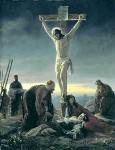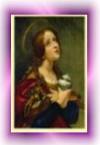

The informative web site Petrus (www.papanews.it), directed by Gianluca Barile, is looking ahead at the work of the investigating Commission on the phenomena of Medjugorje.
To summarize: Official meetings of the new commission will begin after the summer, with the six visionaries summoned to Rome for interviews. Petrus expects that they will be asked to disclose the ten "secrets" which they have refused to give up in previous investigations. The article also reports a suggested compromise idea floated in Rome: that CDF could reject the claims of an apparition, but grant approval to the messages (thousands of them?) as "interior locutions". Is it just a last-ditch attempt to salvage the phenomenon?
Related link:
* How the visionaries dealt with past investigations:
"Questionable games surrounding the 'Great Sign'" (Diocese of Mostar)
My translation of the article follows.
Trickery, interior locutions, or apparitions? The 'seers' of Medjugorje will have to report to the Ruini Commission and submit the ten secrets received (?) from the 'Gospa'
VATICAN CITY - Vicka Ivanković, Mirijana Dragičević, Marija Pavlović, Ivan Dragičević, Ivanka Ivanković and Jakov Čolo, the famous pseudo-seers of Medjugorje, will have to report to the Vatican, probably right after the summer, to respond to questions from the Commission of inquiry - instituted by Benedict XVI, under the presidency of Cardinal Camillo Ruini - assigned to shed light on the alleged Marian apparitions that they have reportedly witnessed uninterruptedly since June 24, 1981. At the same time, the six will be called on to submit to that body, created at the Pope's will, the ten secrets which the Madonna is said to have entrusted to them.
Official meetings have not started yet, but the tendency among the members of the Commission is to meet and 'interrogate' the protagonists of that bruited event in person. The Commission, which took office last March and is eagerly at work to shed light on the supernatural events that call millions of pilgrims from all over the world to the little town of Bosnia-Herzegovina, has already been informed by the Bishop of Mostar on the disobedience of the pseudo-seers to local ecclesiastical authority. Casting shadows on the apparitions, notoriously, are the theological inconsistency of the messages, their contradictions, and the infinite number of the apparitions.
Besides Cardinal Ruini, participants in the Commission are the Cardinals Juliàn Herranz, Jozef Tomko, Vinko Puljic and Josip Bozanić; the Prefect of the Congregation for the Causes of Saints, Monsignor Angelo Amato; Monsignor Tony Anatrella, psychoanalyst and specialist in social psychiatry; Monsignor Pierangelo Sequeri, Lecturer in Fundamental Theology at the Theological Faculty of Northern Italy; Fr. A. David Maria Jaeger, Consultor for the Pontifical Council for Legislative Texts; Fr. Józef Kijas Zdzislaw, Relator of the Congregation for the Causes of Saints; Fr. Salvatore M. Perrella, Lecturer in Mariology at the Pontifical "Marianum" Theological Faculty; the Rev. Achim Schütz, Lecturer in Theological Anthropology at the Pontifical Lateran University (in the role of secretary) and Monsignor Krzysztof Nykiel, official of the Congregation for the Doctrine of the Faith (in the role of assistant secretary). When the Ruini Commission has completed its investigations and expressed its own opinion, it will report to the Congregation for the Doctrine of the Faith, from which the final word is expected.
The establishment of the Commission represents an exception in the history of the Church, in consideration of the complexity of the phenomena that are allegedly happening at Medjugorje. It is naturally too soon yet to know or foresee what the Vatican will ratify in its regard, but in the 'Sacri Palazzi', many among the Cardinals and Bishops of the Curia are certain that at the end the Holy See may recognize these events 'only' as interior locutions of the seers and not as true and proper apparitions. In that way, the pilgrims would be able to continue to go to the little town in Bosnia-Herzegovina to venerate the 'Gospa' (as they call the Virgin there), knowing well, however, that our heavenly Mother is not appearing in that place.
Interior locutions, for the Catholic Church, are messages, from the Trinity or from the Madonna, that seers receive without having apparitions but only hearing a voice. Marian apparitions, in contrast, are events in which the Virgin Mary appears in supernatural form to one or more persons, speaking words or limiting herself to gestures of blessing. Often such apparitions take their name from the city in which they have occurred, or the name given to Mary on the occasion of the apparition, or from the clothing or headdress described.
The phenomenon is a recurring one in the history of Christianity, since the fourth century, but has notably intensified in the course of the 20th century. The first apparition reported dates back to 352, when, according to legend, the Virgin appeared at the same time to a noble patrician couple and to Pope Liberius asking for the construction of a church. According to tradition, the church was in fact built on the site where, a century later, the Basilica of Saint Mary Major was erected, in Rome. Even today the anniversary of the event is celebrated on August 5, the feast of Our Lady of the Snow.
The doctrine of the Catholic Church teaches that the era of public revelation ended with the death of the last Apostle and after the New Testament was completed; as then-Cardinal Joseph Ratzinger recalled in the 1990s, specifically in regard to the Medjugorje apparitions, 'Revelation is already completed in Christ'. Therefore the Catholic Church considers Marian apparitions as a support to the life and the hope of the faithful, but only approves a devotion after a process of investigation (including technical and scientific investigation) in which a favorable opinion is finally expressed (and one cannot assume that this always happens), with the declaration that the phenomenon is indeed paranormal. In the course of history, the Church has often maintained a skeptical attitude in the face of asserted apparitions, very often finding herself faced with pseudo-seers afflicted with mental illnesses, or faced with swindlers harming the faithful.
These are the principal Marian apparitions officially approved by the Catholic Church: Our Lady of the Spring (Caravaggio, Italy, 26 May 1492); Our Lady of Guadalupe (Mexico, 1531); Our Lady of Laus (France, 1664-1718); Our Lady of the Miraculous Medal (apparition to St. Catherine Labouré, Paris, 1830); Our Lady of the Miracle (apparition to Alphonse Marie Ratisbonne, Rome, 1842); Our Lady of La Salette (France, 1846); Our Lady of Lourdes (France, 1858); Our Lady of Pontmain (France, 1871); Our Lady of Gietrzwald (Poland, 1877); Our Lady of Knock (Ireland, 1879); Our Lady of Sorrows of Castelpetroso (Italy, 1888); Our Lady of Fatima (Portugal, 1917); Our Lady of Beauraing (Belgium, 1932 - 1933); the Virgin of the Poor (Banneux, Belgium, 1933); Our Lady of All Nations (Amsterdam, Holland, 1945-1959); Our Lady of Akita (Japan, 1973); Mary, Virgin and Mother (Finca Betania, Venezuela, 1976); Our Lady of Kibeho (Rwanda, 1981); Our Lady of the Rosary of San Nicolas (Argentina, 1983).
It is good to clarify that there is no dogma involved: the Church can only confirm an apparition as worthy of belief, but never requires the faithful to blindly believe in them. For the Magisterium, indeed, it is possible to be a perfectly good Catholic while accepting none of these phenomena. It is sufficient to understand that, in the case when a Marian apparition is considered authentic by church authority, which only approves a devotion, it is considered, as it were, a subordinate source of the Word of God.
On 25 February 1978 the Sacred Congregation for the Doctrine of the Faith published "Procedural norms for the discernment of alleged apparitions and revelations", containing rules which we summarize as follows: the diocesan bishop can start a process, at his own initiative or at the request of the faithful, to investigate the facts concerning an alleged apparition; the bishop can dispense with a thorough examination if he wishes, especially if he thinks that the event is not fruitful; the national episcopal conference can intervene if the local diocesan bishop turns to it; or if the event becomes important at the national level, or at least the regional level of multiple dioceses. The Apostolic See, naturally, can also intervene at the request of the local bishop or of a group of the faithful, or at its own initiative. The investigation proceeds to evaluate the personal qualities of the persons who claim to have the apparitions (mental equilibrium, honesty, moral life, sincerity, obedience to Church authority, good will to practice the normal life of faith) and the content of the revelations themselves (for example, it is necessary to verify that the messages are not in conflict with the faith and morals of the Church, and are free of theological errors). The apparitions will be rejected in the case of doctrinal errors attributed to God, to the Virgin Mary, or to the Holy Spirit in any of the messages; in case of any attempt at financial gain in relation to the supposed events; or of gravely immoral acts committed by the 'seer', or of psychological disorders.
[End of article. Original text at http://www.papanews.it/news.asp?IdNews=15027]
http://catholiclight.stblogs.org/archives/2010/07/from-petrus-the.html

